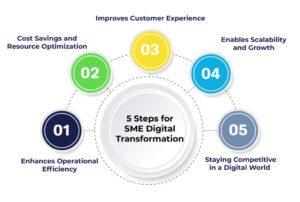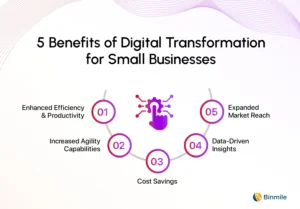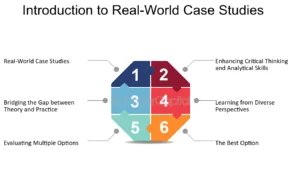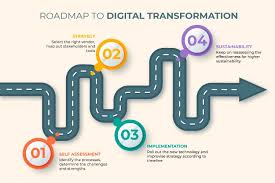
1. Introduction: Why SME Digitalization Matters in 2025
Small and medium enterprises (SMEs) account for 90% of businesses worldwide and contribute nearly 50% of global employment. In countries like India, SMEs (also known as MSMEs) make up almost 30% of GDP and employ more than 110 million people.
In 2025, digitalization is no longer optional. The post-pandemic world, rapid e-commerce growth, and technological disruption have made digital-first operations a survival necessity. Whether it’s a small bakery in Mumbai, a fashion boutique in Paris, or a tech startup in California — SMEs that adopt digital tools are outpacing competitors in growth, efficiency, and customer satisfaction.
SME digitalization means more than just having a website. It includes:
-
AI-powered automation for routine tasks
-
Cloud-based tools for affordable scalability
-
Digital payments for faster transactions
-
E-commerce platforms for global market access
-
Data-driven decision-making for smarter growth
👉 SMEs that embrace digitalization are projected to grow 2x faster than traditional businesses by 2030.
2. Global Drivers of SME Digitalization

Several global trends are driving SME digital adoption in 2025:
AI and Automation
AI is no longer just for tech giants. Affordable SaaS platforms now offer SMEs tools for:
-
Chatbots to handle 24/7 customer queries
-
Predictive analytics for inventory and sales
-
Automated HR and payroll systems
💡 Example: A small clothing brand using AI-powered chatbots on Instagram can handle 60% of customer queries without human intervention.
Cloud Computing
Cloud adoption gives SMEs enterprise-level efficiency without massive upfront investment. By 2025, 85% of SMEs worldwide rely on cloud platforms.
Benefits:
-
Real-time collaboration
-
Remote workforce enablement
-
Reduced infrastructure costs
Digital Payments and Fintech Growth
Fintech has revolutionized transactions for SMEs.
-
In India, UPI crossed 10 billion monthly transactions in 2025.
-
In Africa, mobile money platforms like M-Pesa enable small farmers and traders to operate digitally.
-
SMEs now access microloans and embedded finance directly through digital platforms.
E-commerce and Online Presence
E-commerce isn’t just for big retailers.
-
Platforms like Shopify, Amazon, Flipkart, and Etsy empower SMEs to sell globally.
-
Social commerce is booming — WhatsApp Business, Instagram Shops, and TikTok Shops allow SMEs to connect directly with customers.
-
By 2025, 45% of SME sales are influenced by digital channels.
Government Policies and Support Programs
Governments are actively supporting SME digitalization:
-
India: Digital MSME scheme, Startup India support, Udyam registration benefits.
-
EU: SME Digital Strategy focusing on innovation and cross-border trade.
-
US: Small Business Administration (SBA) digitalization grants.
3. Benefits of SME Digitalization

Efficiency and Productivity Gains
Automation reduces repetitive work, freeing employees for higher-value tasks. SMEs report 30–40% faster operations after adopting cloud-based workflows.
Cost Savings and Scalability
Digital tools allow SMEs to start small and grow. Instead of investing in heavy infrastructure, businesses pay monthly SaaS subscriptions.
💡 Example: A 10-person accounting firm uses cloud-based accounting software, saving 20% annually in operational costs.
Improved Customer Experience
Personalization is the new business currency. SMEs can use CRM software and AI-driven analytics to:
-
Track buying patterns
-
Send personalized offers
-
Provide faster, better service
Global Market Expansion
SMEs are no longer confined to local markets. E-commerce enables them to reach international buyers.
-
A Jaipur handicraft shop selling globally via Etsy
-
A South American coffee brand shipping directly to Europe
Better Data-Driven Decisions
SMEs using analytics tools gain insights into sales trends, customer behavior, and operational efficiency, enabling smarter, faster decisions.
4. Challenges in SME Digital Transformation

While the benefits are clear, SMEs face hurdles on their digital journey:
Budget Limitations
Most SMEs operate on limited budgets, making advanced technology investments difficult.
Digital Skills Gap
Employees often lack digital literacy, slowing adoption. Governments and private players are introducing training programs, but the gap remains.
Cybersecurity Risks
Cyberattacks on SMEs have surged 300% since 2022. SMEs often underestimate the need for robust security, making them easy targets.
Cultural and Organizational Resistance
Traditional family-owned SMEs may resist change due to fear of complexity or disruption of existing processes.
5. Case Studies and Real-World Examples

-
India’s Kirana Stores (Retail SMEs):
Small corner shops adopted UPI and WhatsApp Business, becoming digital-first microenterprises. Some now generate 20–30% higher revenue thanks to digital payments and online orders. -
European Furniture SME:
A mid-sized furniture business adopted a cloud ERP system, cutting inventory wastage by 20% and improving delivery times. -
African Agribusiness:
Farmers in Kenya use mobile payment platforms like M-Pesa for transactions, enabling access to banking services and larger markets. -
US Retail SME Using Shopify:
A small clothing retailer scaled nationwide by leveraging Shopify, AI-driven marketing, and Instagram ads. Sales tripled in two years.
6. The Future of SME Digitalization: 2025 and Beyond

-
AI Democratization: More AI tools will become affordable for SMEs.
-
Blockchain Adoption: SMEs will use blockchain for transparent supply chains and secure contracts.
-
Green Digitalization: Eco-friendly operations integrated with digital tools will become a competitive edge.
-
Cross-Border E-commerce Growth: SMEs will increasingly sell globally, aided by logistics and digital trade policies.
-
Human + Machine Collaboration: Instead of replacing jobs, digitalization will enhance productivity by combining human creativity with machine efficiency.
7. Roadmap: How SMEs Can Begin Their Digitalization Journey

-
Assess Current Readiness – Identify gaps in processes and technology.
-
Define Clear Goals – Growth, cost reduction, or customer engagement?
-
Choose Scalable Tools – Start small with SaaS tools like Zoho, QuickBooks, Shopify.
-
Upskill and Train Employees – Invest in digital literacy programs.
-
Strengthen Cybersecurity – Use firewalls, encryption, and employee awareness programs.
-
Leverage Government and Industry Support – Tap into schemes, grants, and training programs.
-
Monitor, Measure, and Scale – Track KPIs and expand digital adoption gradually.
8. Conclusion 
SME digitalization in 2025 is not just a trend — it’s the lifeline of modern business. From AI to e-commerce, digital tools empower SMEs to reduce costs, enhance customer experience, and expand globally.
SMEs that embrace technology will thrive in the digital-first world, while those who resist may face obsolescence.
Relevant Blogs:-
